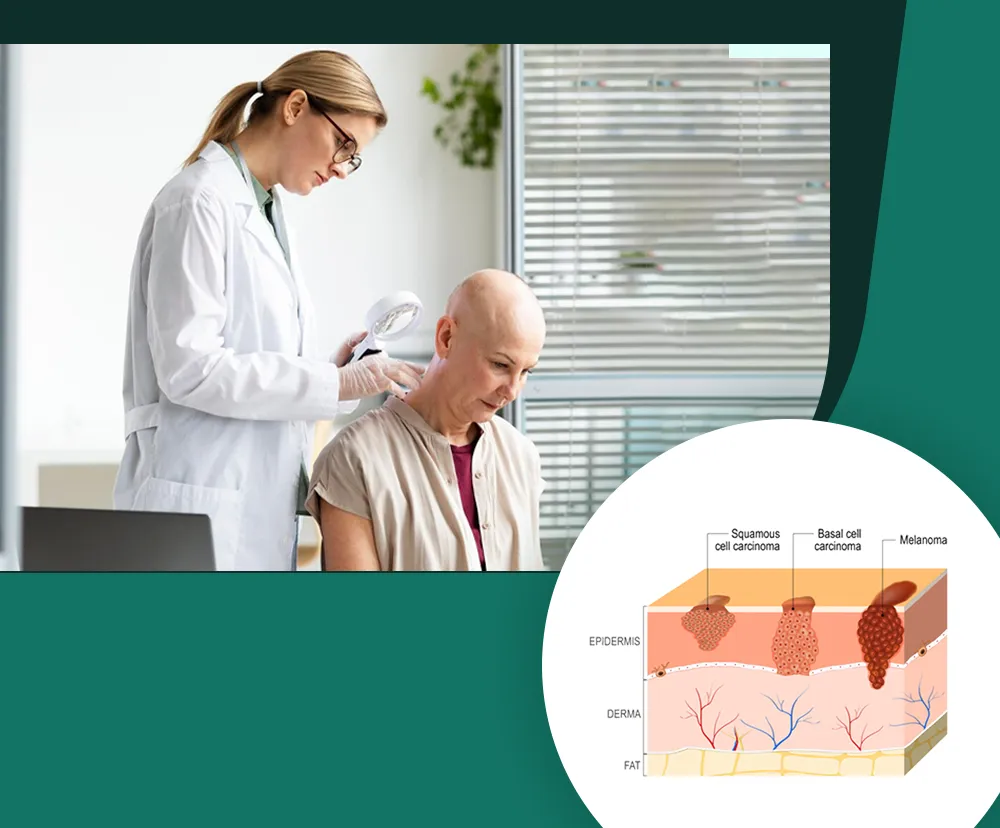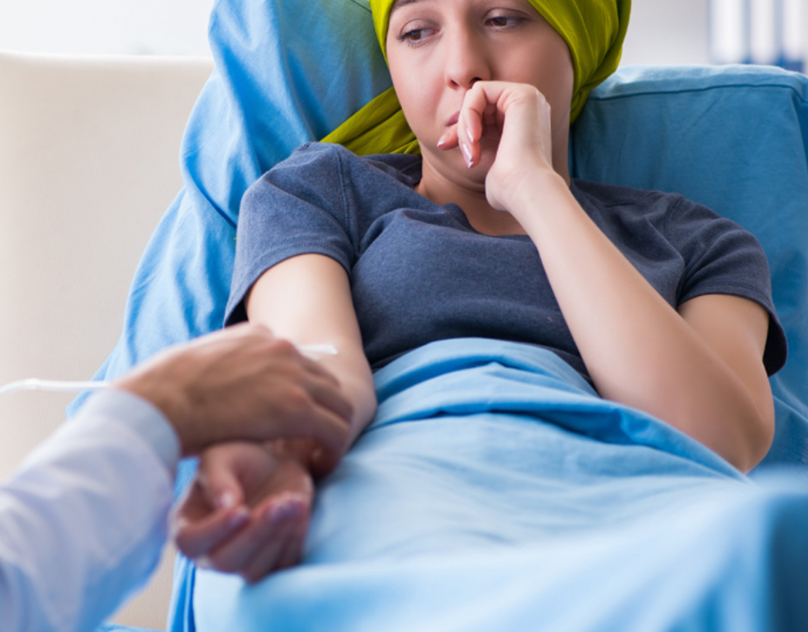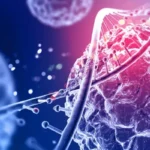Squamous cell carcinoma treatment
Squamous cell carcinoma treatment
Introduction
Squamous cells are cells that protect your organs. Cells found on the external layers of your skin are squamous cells. Such cells also offer linings to arteries and body cavities. The cells you find on linings of your gastric tract and respiratory tract are also squamous cells. Squamous cell carcinoma is also called epidermoid carcinoma.
Squamous cell carcinoma varies from one site to another. Each affected site may differ in terms of signs, diagnosis and how the condition responds to treatment. Research indicates nearly 88% of head–and–neck cancers belong to the genre called squamous cell carcinoma. This includes cancers in nasal cavities, oral parts like throat, etc.
On human skin, squamous cell carcinoma fares among top 3 types of skin–cancers; skin–based squamous cell carcinoma accounts for nearly 900,000 cases in US per annum. Cancers of food pipe i.e., esophagus – is either adenocarcinoma or squamous cell carcinoma (SCC). Cancerous conditions occurring nearer to your mouth represent SCC. On the other hand, conditions nearer to your tummy are due to adenocarcinoma. The former makes it difficult to swallow the foods you eat. This condition is known as dysphagia.
SCC on lungs shows–up among people who smoke tobacco–products. In the prostate region, SCC is quite aggressive. It makes it a tough–thing to detect it at an early–stage. This is because, an enhancement in antigen–levels remains elusive at large. This is one of the reasons for diagnosing prostate-specific SCC at an advanced stage.
Stages of squamous cell carcinoma
Regardless of the condition being moderately–differentiated SCC or well–differentiated SCC, physicians bucket this autoimmune condition into 5 stages – from 0 through 4.
Stage 0 of SCC: At this stage, abnormal cell growth is observed on the top–most surface of the affected tissue or skin. Two aspects hold–good here: 1. Carcinoma has not yet spread–out and 2. it has not turned into a cancerous condition yet. Physicians call stage 0 as carcinoma in situ; it is also referred to as Bowen’s disease.
In most cases, stage 0 of SCC is seldom palpable. If it does become visible, it manifests as dis–coloured patches on skin, changes in texture of nails, red or white–coloured patches in your mouth, a burning feeling inside your eyes and / or itchy eyes. Another stage–0 condition is called actinic keratosis. This is triggered by frequent exposure to UV radiations of sunlight. This forms as scaly and roughened patches on skin. It can cause brown or red–colored spots on skin.
Stage 1 of SCC
At this stage, tumors are of a very–small size but have not yet spread to lymph–nodes. Signs can become palpable either as a lump or lesion. On your oral parts, lump or lesion is likely to below 2 centimetres (2 cm) in width. You may witness profuse bleeding from the site. You need to know that lymph–nodes are very much part of your lymphatic network. If SCC spreads to lymph–nodes, it soon moves to other parts of your body
Stage 2 of SCC
This stage is when carcinoma gets deeper into your skin. However, it is unlikely to spread to adjoining lymph–nodes. On your oral parts, size of tumors may reach ~3 cm. You tend to experience pains and allied discomforts than what you felt in stage–1.
Stage 3 of SCC
At this stage, tumors get bigger and can spread to neighboring lymph–nodes. This stage also makes cells to multiply further and deeper on tissues. The condition may grow to nearer muscles and bones. In terms of signs, tumors may grow larger than ~ 4 centimeters. In your mouth, your ability to swallow suffers if tumors develop at the root of your tongue or throat. Often times, you may feel a bump or a lump inside your throat.
Stage 4 of SCC
At this stage, SCC can manifest in any physical dimension or size. The condition may spread to more than one lymph–node, to your bone–marrow or bones, and to vital–organs like brain or lungs. Your pains may worsen and are often accompanied by an inexplicable loss of body weight; being tired, respiratory difficulties like gasping, difficulties while swallowing and changes in the functioning of your brain are other signs.
Treatments for SCC
Treatments vary for moderately differentiated SCC and for well-differentiated SCC. In case of moderately differentiated condition, an aggressive approach of removing pre-cancerous growth of cells is recommended. Such an approach halts SCC from spreading any further.
Treatment plans include surgical interventions for cutaneous SCC. Your surgical team removes 1 or 2 layers of your skin along with adjoining tissues. The team then assesses the site underneath a microscope to find if residual cells exist. This surgical process is repeated till all cancerous cells are completely removed.
In some cases, cancerous cells are scrapped-off with the help of a curette. It sears your skin and destroys cancer-causing cells. This procedure too is repeated until surgical teams are satisfied with their scrape-off.
If SCC spreads to other organs and lymph-nodes, a combinatorial approach is taken. Such an approach includes intake of drugs, exposure to radiations and photo-dynamic therapies. US-based FDA has cleared some drugs for both moderately-differentiated SCC and for well-differentiated SCC. Typical drugs include pembrolizumab, cemiplimab, etc.; such drugs form part of immunotherapies.
For radiation treatment, high-energy x-rays are used to destroy cancerous cells; exposure to such high-energy radiations is planned several times each week. These sittings last for a few weeks’ time.
In case of photo-dynamic therapies, substances that are sensitive to ultraviolet light-sources are used. These are applied onto the affected-sites and are then exposed to intensive light-rays. This helps burning of cells that cause SCC. Aforesaid combinatorial approaches are planned to those who cannot undergo a surgery.
It is unlikely for SCC to become a fatal condition. This is chiefly due to the ability to detect the changes and start needful treatments at an early stage. Odds of SCC to spread to other parts are also quite low. Such spreading is however more likely among people with a severely compromised immunity. This is one of the reasons this type of carcinoma has a very-slim chance – of < 2.2% – to turn into a metastasized condition.
All these do not indicate that SCC is not a dangerous condition. The more delayed its diagnosis is, the higher are the chances for it to spread to other organs. You also need to remember that this type of carcinoma develops deep inside your body, it is difficult to diagnose and treat it. It is a good practice to consult with a qualified caregiver about inexplicable changes seen on your skin.
In order to simplify things further, watch out for hardened bumps on your skin or when you see wounds / sores, scaly or roughened patches on the lips of such sores, and for raised, wart-like open sores. So, when do you need to you see your physician? You are advised to seek an appointment with a certified clinical practitioner if a scab is not getting cured for > 8 weeks. It may be necessary to see a doctor when a scaly patch on your skin does not go-off on its own.
SCC on skin is not uncommon among those who have lesser level of melanin in skin. Melanin is a chemical which gives color to your skin. It is this chemical that protects your skin from harmful UV rays of sun. In general, those with brown or black-colored skin are known to have more amount of melanin than those with white-skin. Studies done on SCC indicates higher risks to those who sunburn with relative ease.
You are advised to limit your outdoor time, especially when the sun is out. You can wear protective clothing or use sunscreen to lessen risk-levels. On the same note, stay away from using suntan booths. As a child, if you had frequent spells of sunburns or blisters, odds are high for SCC to set-in. If you find sores or scars developing on your skin, and if they do not get cured soon, these can be an onset of SCC.
It is highly recommended to opt for periodic medical check-ups. These check-ups can shed light on changes in birthmarks, freckles or moles. You may use mirrors to detect newer growth of bumps or lumps on neck, scalp and face. As a precautionary measure, do a physical examination of your armpits, tongue and legs and feet – including bottom areas of your feet and spaces in between your toes. If you want to know more about SCC, talk to your physician or a certified oncologist.
Related Blogs :

What is chemotherapy?
What is chemotherapy? Introduction What is chemotherapy? Types of chemotherapy Chemotherapy process Chemotherapy side effects Introduction Autoimmune conditions like cancers show up via rapid reproduction of cells...

Dr. Rajasekar is a cardiologist in Chennai, with extensive experience in the field. He completed his MBBS from Madurai Kamaraj University, followed by an MD in General Medicine and a DM in Cardiology from The Tamil Nadu Dr. M.G.R. Medical University (TNMGRMU).



